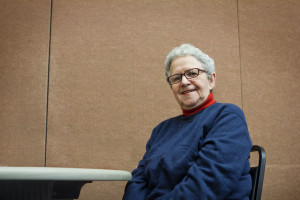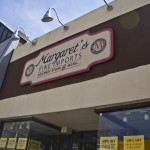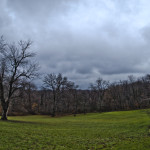The heart of Squirrel Hill beats at the JCC
by Patricio Chile
The dining room at the Jewish Community Center of Squirrel Hill is alive with stories. Sitting alone at a table in the crowded “J-Café,” Shulamit Bastacky, a cheerful woman wearing dark rimmed glasses and an orange sweater, is anxious to share hers.
“I’m a Holocaust survivor,” she says. “I was born during the war. I was hidden and a Catholic nun risked her life to save mine.”

Shulamit Bastacky, a JCC regular and a Holocaust survivor, enjoys the atmosphere of Squirrel Hill. Photo by Hu Almutawathem
The room is clamorous as seniors from the JCC’s “AgeWell” program eat and chat. Amid the noise, Bastacky says that she was born in Wilno, Poland, now Vilnus, the capital of Lithuania. She was hidden in a basement for the first few years of her life. After the war she reunited with her family and later moved with them to Israel, then to Pittsburgh, in November 1963.
“Next month will be 50 years since I discovered America,” she says. “In English all I knew was yes, no, okay. That was the extent of my vocabulary. “
Bastacky worked hard, eventually graduating from the University of Pittsburgh with a Bachelor’s degree in social science and a Master’s degree in social work. Before retiring, she worked at the University of Pittsburgh for a number of years. Today, she spends a lot of her free time at the JCC.
“What you see in this building is just a building with walls, ceilings, and a wonderful looking place. But you see human beings of every walk of life, from little infants to people in their 90s…you see here different races and nationalities,” she says.
Bastacky’s observation gets to the heart of the JCC’s story. Located in a large brick structure off the corner of Murray Avenue and Forbes Avenue, the JCC is emblematic of a Jewish community that has been a mainstay of Squirrel Hill since the early 20th century.
Today, members seem more than eager to share that legacy with a community becoming increasingly diverse. Walking through the lobby, a large glass display along the wall touts the “Jewish Hall of Fame,” which features key members of the local Jewish community. Across from the J-Cafe, a long hallway leads to the JCC’s Early Childhood Development Center. A colorful wall, bright yellow and punctuated by knobs, runs the entire length of the corridor. Running parallel to it, just below, is a long undulating wooden panel.
Kelly Gable-Lavelle, the director of the Development Center, is eager to demonstrate the significance of the display. She explains that the top portion of the panel represents the Hebrew calendar. Each knob represents a day. The Hebrew months are listed above the knobs, the Gregorian (Western) calendar months below.
The swerving wooden panel, etched by a robotic laser, represents the different phases of the moon along the calendar year. Gable-Lavelle says the display gives young children an important visual reference for the concept of time as well as Jewish culture.
“Time is ambiguous to children under the age of five,” she says. “So for many years it fit within our Jewish calendar, to teach them about the moon phases. [We] noticed the children talking about the shapes of the moon, what they meant, and noticed children were connecting them to Jewish holidays.”
Gable-Lavelle calls the display a “touch-wall.” Teaching through sensory integration, sight, sound and touch is a key goal, she says.
Rabbi Donni Aaron, who teaches at the Development Center, agrees with this mission. She recorded a CD of Shabbat songs with children at the day school and says the project led to surprising feedback from students and parents.
“It was actually the non-Jewish parents that seemed most excited about the CD,” she says.
Aaron started at the JCC in 2010. Before that, she worked in Jewish communities in Los Angeles and Chicago. She says the Jewish community of Squirrel Hill is one of the few she’s been to where the different spectrums of Judaism – both conservative and reform – worship and celebrate together. Walking around Squirrel Hill, she says she is often recognized by different people in the community, especially when wearing her kippah, the head covering traditionally worn by men in the Jewish community.
She wears one in public, partially to show girls it is okay to do so.
Aaron recalls a particular experience from teaching at the JCC that stands out to her. A boy from a Catholic family pointed to her kippah one day and commented that it was similar to the head covering worn by the Pope. She responded that it was indeed similar and pointed out the shared origins of both religions. Experiences like that, she says, demonstrates the unique opportunities the JCC offers for education through sharing.
“It’s about exposure and education,” she says.
Bastacky, for her part, says sharing has other benefits, which include decreasing hate and intolerance in order to ensure peace.
“Meeting people from so many different backgrounds and cultures enriches my life, makes my life better and richer for it,” she says. “It’s wonderful.”
 Previous Post
Previous Post Next Post
Next Post